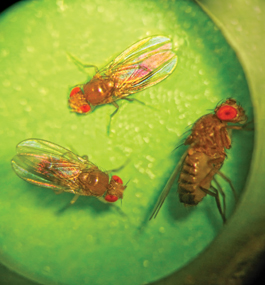A Most Fruitful Scientific Partnership

Mike Lovett
You gotta love the fruit fly.
Sure, they start out as revolting maggots, devour ripening fruit and infest the garbage pail. But they’re also invaluable scientific model organisms. The bristly bugs have helped transform our understanding of biology. Eight Nobel Prizes have been awarded to scientists for research using fruit flies.
Why do scientists find fruit flies so fruitful? First, Drosophila melanogaster, as they’re scientifically known, are small. Thousands can be housed in a lab.
Second, they have relatively simple physiological systems, so they are easier to use experimentally than rats.
Third, they breed quickly. Females can lay 30-50 eggs a day; the eggs hatch within two weeks (maybe the expression should be “breed like fruit flies”). Several generations can be bred within the span of a few months, giving geneticists a valuable tool with which to understand gene function.
Finally, fruit flies share nearly 60 percent of our genes, including those responsible for Alzheimer’s, Parkinson’s, cancer and heart disease.
“I love working with fruit flies, because I can tackle scientific questions from the molecular level to the whole-organism level,” says associate professor of biology Avital Rodal, who studies the biology underlying amyotrophic lateral sclerosis (ALS). “I can tap into a wonderful and generous community of many thousands of fruit fly researchers with more than a hundred years of accumulated knowledge, fly strains and ideas.”
Drosophila research began in the early 1900s when American biologist Thomas Hunt Morgan set up his “Fly Room” at Columbia University. Morgan spent 17 years in the cramped, dusty, cockroach-infested room, breeding millions of flies and searching for changes in traits between confirmed the role chromosomes play in passing genetic traits from generation to generation, earned him the Nobel Prize in Physiology or Medicine in 1933.
Two of Morgan’s students, Alfred Henry Sturtevant and Hermann Joseph Muller, made further discoveries about genetics using flies. Muller, for instance, showed that X-ray irradiation causes genetic mutations in flies, a finding that led him to voice his opposition to nuclear weapons.
In the 1960s, Caltech’s Seymour Benzer and Ronald Konopka showed that the fly’s per (for “periodicity”) gene regulated its circadian rhythms.
Scientists who work with flies can name the genes they discover. As a result, “swiss cheese,” “dreadlocks,” “cheap date,” “hamlet,” “smurf1,” “smaug” and “ménage-à-trois 1” are part of the nomenclature. The groucho gene was so named because mutants develop an excess of facial bristles.
At Brandeis’ Oct. 2 press conference celebrating Michael Rosbash and Jeff Hall’s Nobel Prize in Physiology or Medicine, Rosbash gave credit where credit is due.
“This is a testament to fruit flies,” he said.
— L.G.
